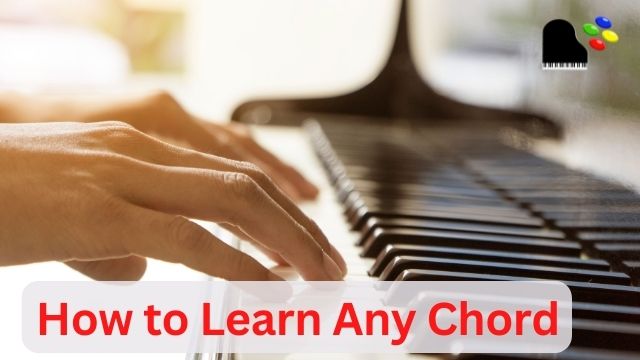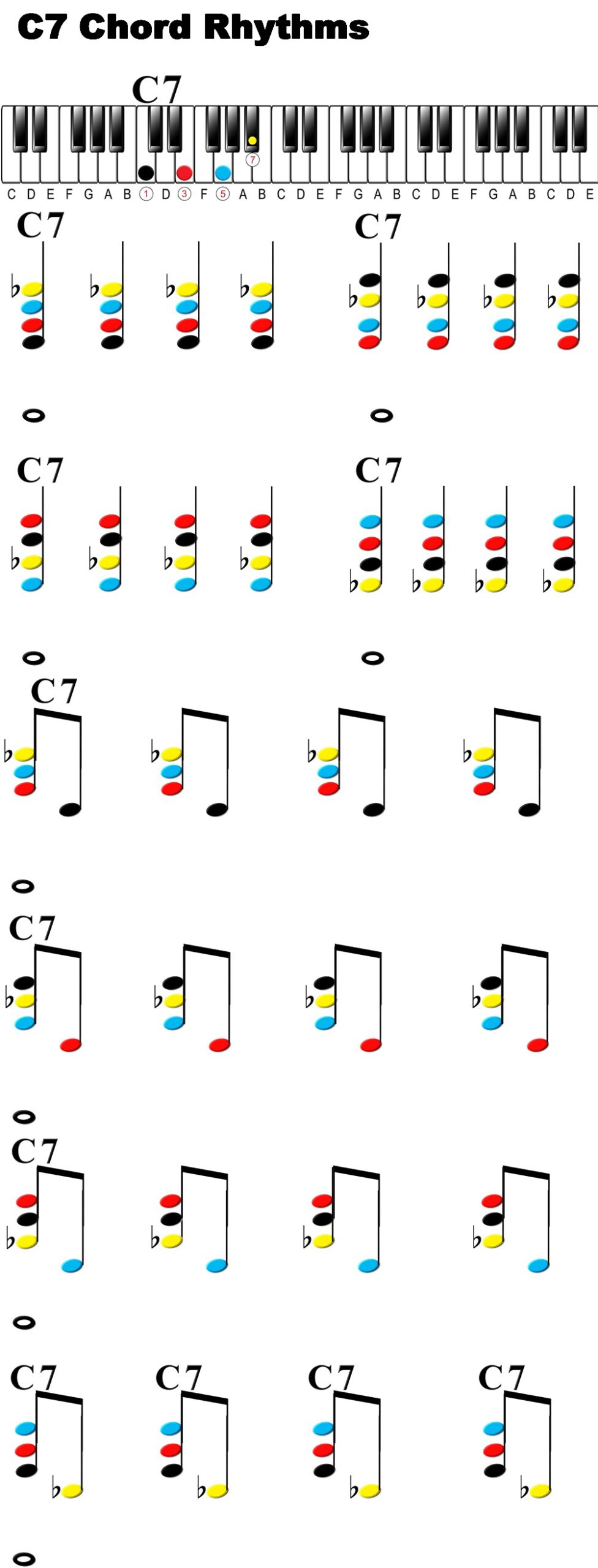When I was a traditional piano student, I not only didn’t know how to learn any chord, I didn’t really understand the concept of chords. As you may know, traditional piano lessons focus on reading standard music notation. 
As a contrast, guitar instruction has always been chord based. I believe that’s the appeal for the guitar as a popular instrument. Chords are groups of notes and can be simply notated with chord symbols.
But this doesn’t mean that piano players are left out. Outside of traditional piano lessons, you’ll find that the key to playing popular music at the keyboard lies in the magic of chords.
I want to share with you a simple process for how to learn any chord and how to study any chord and make it easier to play and remember.
The Origin of Chords
As you may know, chords aren’t random notes. The notes of any given chord belong to a group of notes known as a scale. They can also be referred to as a key of music.
also be referred to as a key of music.
The most basic chords are Major and minor chords that are also known as triads. Both of which can easily be derived from Major and minor keys of music
Each Major key has its own corresponding Major chord. It’s easy to understand because the Major key and Major chord have the same name.
The Key of C Major
The first, third and fifth tones of the key are used to construct the Major chord.
C Major Chord
The same goes for the minor chord. You can easily find the corresponding minor chord from the minor key.
The Key of C minor
The same formula of the first, third and fifth tones of the key are used to construct the minor chord.
C minor Chord
There are other triads as well as extended chords but we won't cover those here because this article is about how to learn any chord with a simple process.
The Major and minor triad examples I’ve shown you here are in the most basic position known as root position. It would be fine to only learn them in this context if all chords were played this way but they’re not.
Chords are played in different inversions and voicings which change their appearance and sound. Without having this flexibility, chords would have a very limited musical context.
This may make how to learn any chord more challenging, but it’s not difficult when you have the tools to understand and recognize chords in any concept.
Inversions & intervals
As I stated earlier, the Major/minor triads are constructed of the first, third and fifth tones of their respective keys. When you invert these triads, these tones don’t change but the intervals between them will. Let's just look at the C Major triad as an example.
A Major triad in root position is constructed of a Major third and a minor third in that order.
C Major triad root position intervals
Notice how the intervals change as you invert the triad.
C Major triad 1st Inversion
Perfect 4th and a Major 3rd 
C Major triad 2nd Inversion
Minor 3rd and a Perfect 4th
You must recognize the intervals as well as the tones that make up the chord. This is simpler with triads than with more advanced chords. However, it does become easier with repetition. The point is to learn to recognize any chord in any inversion.
The Number System
Along with understanding the tones that make up a chord, the numbers that make up a chord are just as important. The number system is a system of transcribing music
by assigning a number to each tone in a scale or key of music.
Key of C Major (numbered)
The number system shows the structure of any chord or key of music. In this way, any one chord can be transcribed to any other key just by knowing the numbers that chord consists of.
C7 chord
F7 chord
G7 chord
* The previous chords are dominant 7th chords in which the 7th is lowered a half step.
Notice how the notes are different but the numbers are the same. Learn the number system. Without it, learning chords and keys of music take far longer and don’t allow you to easily transcribe chords effortlessly.
Learning Chords With Rhythmic Patterns
It’s very simple to learn how any chord is constructed. But the secret of how to learn any chord and be able to recall it with little effort is to play it in a musical context. A Simple way to accomplish this is to play chords with rhythms while also inverting the chord.
Let’s take a C7 chord as an example. First of all, get this C7 chord under your hand in all inversions.C7 Root Position C7 1st Inversion
C7 1st Inversion C7 2nd Inversion
C7 2nd Inversion C7 3rd Inversion
C7 3rd Inversion
Now we can create a simple rhythm with this one chord.
C7 3/1 Break-up Rhythm
To create a more musical rhythm, add the left hand just by simply playing the root.
Watch the Video Below to see how to get more creative on how to learn chords with Rhythmic Patterns
Rhythmic Repetitions
How do you really get good at something? With repetition of course. If you incorporate this concept of studying chords into your regular piano study sessions, you’ll be amazed at your progress. And it won’t take as long as you may think.
I’ve given you an example of just one dominant 7th chord. But there are 12 of them. That opens up the opportunities to learn even more chords and voicings. You should also remember to study other types of chords and voicings such as Suspended, augmented, 9th, 11th, 13th, etc.
When you focus on one type of chord by playing inversions/rhythms, you're doing it in a musical context. This keeps you motivated and engaged. You're also developing your kinesthetic sense which is essential to developing the physical skill that's also necessary.
Until next time, Go Play.
Greg Lee
Latest posts by Greg Lee (see all)
- What is a minor/Major 7 Chord? - October 26, 2023
- 7 Chord Substitutions that Professionals Use - October 19, 2023
- 5 Simple Chord Tricks to Sound Amazing - October 5, 2023



